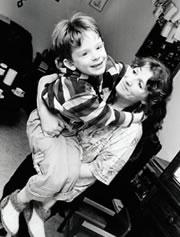 Autistic children display a wide range of different symptoms.HENNY ALLIS / SCIENCE PHOTO LIBRARY
Autistic children display a wide range of different symptoms.HENNY ALLIS / SCIENCE PHOTO LIBRARYHalf of all cases of male autism may be caused by spontaneous genetic mutations, say researchers who have studied the genetic patterns of the condition. Offspring who inherit such mutations are at a greater risk of having an autistic child themselves.
Autistic people have difficulty relating socially with others and tend to focus obsessively on a narrow set of interests. Three to six out of every 1,000 people are expected to have the condition; its cause is unknown but there is thought to be a strong genetic component.
"That genetics plays a major role in autism has been obvious now for 20 years or more," says Isabelle Rapin, a neurologist at Albert Einstein College of Medicine in New York, who was not affiliated with the study. "The evidence for genetics is not controversial."
But determining how genes affect autism has been difficult. Autism is a complex disease with a wide range of symptoms and severity. It also affects four times more males than females, for unknown reasons.
Spontaneous mutation
Earlier this year, a genome-wide scan linked some cases of autism with mutations in the number of copies of certain genes. Ten per cent of autistic patients had copy-number mutations that were not present in either parent, showing that the mutations were spontaneous1.
But Michael Wigler, a geneticist at Cold Spring Harbor Laboratory in New York and a lead author on the study, says that the study probably missed some copy-number mutations. "We were sure that 10% was an underestimate," he says.
So Wigler and his colleagues turned to a database containing pedigrees of families with two or more autistic children and asked: if the family's first two children were autistic, what were the chances that the third was autistic as well?
In 86 families with two autistic children and a third, male child, 42 of the third-born children showed autistic symptoms, the researchers report in Proceedings of the National Academies of Sciences2.
This suggests that parents had a one-in-two chance of passing on a mutation to their offspring, matching a dominant inheritance pattern. Another database gave the same result.
Handed down
Using mathematical models, Wigler's team found that the simplest way to describe the patterns of autism inheritance was to divide parents into two risk classes: those who carry a pre-existing autism-causing mutation, and those who do not.
The models suggest that about half of autistic children are born to parents with no previous genetic predisposition to autism, suggesting that the cases are caused by spontaneous mutations.
Older mothers, who are more likely to have autistic children, could fall into this class, notes Wigler. Such mothers' eggs have had more time to accumulate mutations.
ADVERTISEMENT
Once those spontaneous mutations have been passed on, the offspring — particularly women, who can carry the mutation without showing symptoms — have a high risk of having an autistic child. Males with the mutation would also bear this risk, but are also likely to be autistic and therefore less likely to have children.
The researchers' model suggested that about a quarter of autistic children have inherited a copy-number mutation from their parents.
"It's a new way of looking at the data," says Rapin. Future studies using data from other family members are needed to further test the new models, she says. Other factors, such as complications during pregnancy, and the influence of multiple genes, may also be important in causing autism.
Visit our mutationsimplicatedinha.html">newsblog to read and post comments about this story.
